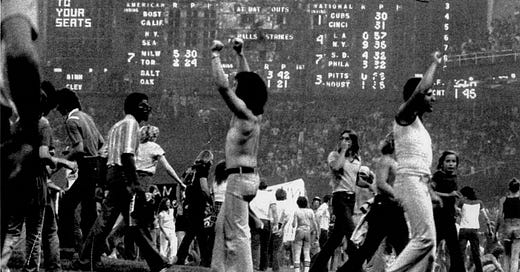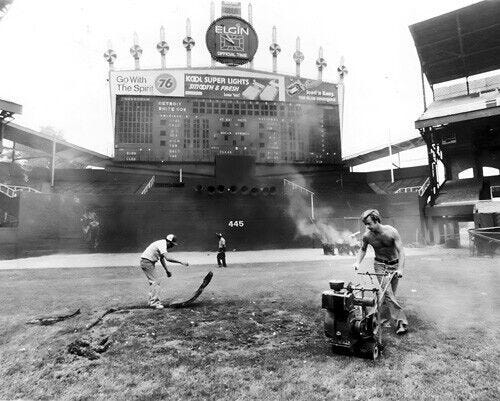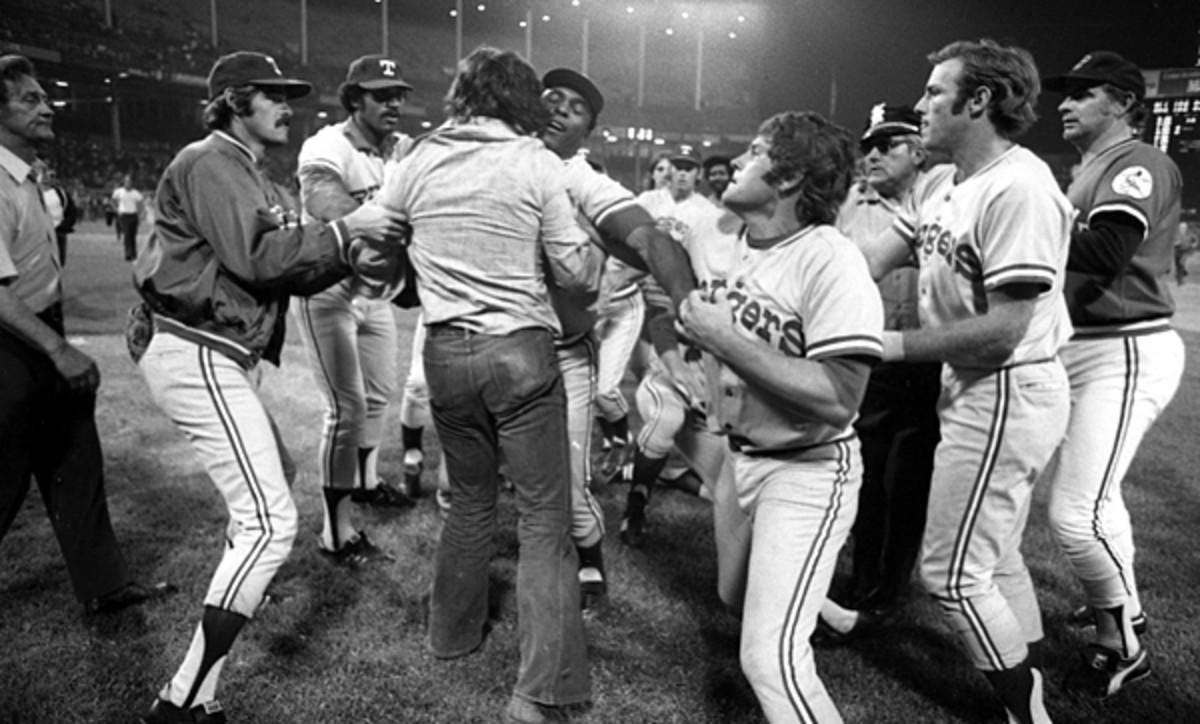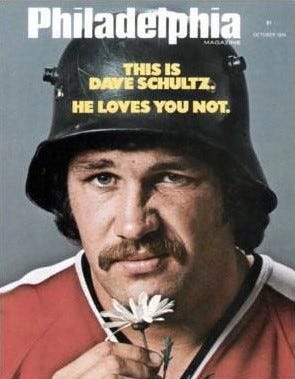Let’s Start a Riot!: The Story of Sports Chaos in the 1970s
During the 1970s fans were ready to riot at the drop of a hat
It was all supposed to be harmless fun…and then all hell broke loose. It was July 12, 1979, and Chicago White Sox were hosting the Detroit Tigers at Comiskey Park for a doubleheader. The White Sox were not a good team, and the Tigers would finish the year with a winning record but had no hope of making the playoffs. Nobody was expecting anything special when these two clubs played each other. White Sox owner Bill Veeck and his son Mike, who was the marketing director, had come up with several publicity stunts like bringing in circus animals and belly dancers, and installing showers in the grandstands to attract fans to watch their mediocre team. One of their promotions was Disco Night and upon seeing there was an equally anti-disco fan base, Mike Veeck recruited Chicago anti-disco shock jock Steve Dahl for a promotion called Disco Demolition Night. Fans who brought a disco record to the July 12th doubleheader would get in for ninety-eight cents and in between the games, Dahl would blow the records up. Mike was anticipating 10,000 fans to turn up, his estimate was off by about 40,000. Many of these patrons were not baseball fans. They were fans of Dahl. They threw records and cherry bombs on the field during the first game. Tigers relief pitcher Aurelio Lopez refused to warm up in the bullpen out of fear for his safety and White Sox outfielders wore batting helmets to protect themselves.
When Steve Dahl made his grand entrance in a Jeep while adorned in army fatigues and helmet, the crowd threw more cherry bombs and bottles onto the field. Dahl was undeterred and made his anti-disco speech and blew up the records which had been placed in a giant box in center field. A young man ran onto the field, slid into second base, picked it up and displayed it to the crowd. That was their informal cue to storm the field. The fans set fires in the field while chanting “disco sucks!” The police were called to break up the riot and the second game was cancelled.
Disco died that night. In the decades since Disco Demolition Night, cultural critics and queer theory scholars have written extensively about how it was a racist and homophobic backlash against disco. I am not going to deny that this was part of the reason why Disco Demolition Night devolved into chaos. Although in my opinion the anti-Disco backlash had more to do with corporations overexposing the genre and rock fans who grew to detest disco were not angry with the genre and its dominance per se. They were more upset that their favorite artists like Rod Stewart, KISS, and The Rolling Stones shamelessly cashed in on the disco trend. These critics are also making their analysis without taking into account the broader social trends at the time particularly when it comes to the atmosphere at sporting events. Sports fans in the 1970s wanted to do two things, see their team win and cause trouble…and not necessarily in that order. Sometimes seeing their team win wasn’t a priority. Causing bedlam was enough for them to get their kicks. Why? Because it was the 1970s and there were no rules.
Sports riots happened before the 1970s. On November 8, 1963, at the Roosevelt Raceway in Long Island, New York, several horses crashed into one another midrace and only two were able to cross the finish line. The 23,000 fans in attendance wanted the race to be ruled a no contest. When the judges upheld the results, the fans, the majority of whom almost certainly had money riding on the race, rioted in response and attempted to attack the judges. On July 4, 1910, when boxing’s first black heavyweight champion Jack Johnson defeated white James J. Jeffries, white Americans who abhorred having an African-American champion rioted throughout the country. Mobs attacked African-Americans who were celebrating Johnson’s victory in over a dozen different cities. Hundreds of people were injured, and it is estimated that nearly two dozen were killed. However, what made the 1970s different from previous eras in sports is that riots were quite common and there was a general sense of unrest during many of the games.
Trouble in the Capitol
On September 30, 1971, the Washington Senators played their last home against the New York Yankees before they were due to move to Dallas the following season to become the Texas Rangers. This was the second time Major League Baseball had tried to make a franchise in the nation’s capital work. The second Washington Senators incarnation was one of the worst teams in baseball during their eleven seasons. They had only one winning season but otherwise averaged over 90 losses a year.
Their final game was a riot. Literally. It was marked by bitterness and then bedlam. D.C. baseball fans who longed for the glory days of Walter Johnson and were paying for the most expensive tickets in the league, entered RFK Stadium without paying and the security guards walked off the job. Fans unfurled a banner in the outfield with a message to owner Bob Short which said, “SHORT SUCKS”. Even the Senators pulling ahead in the game did nothing to pacify them. It only seemed to make them angrier. The game was briefly delayed in the eighth inning when a group of fans ran onto the field, but the game continued once the police apprehended them. The Senators were winning 7-5 with one out to go in the bottom of the ninth inning, but the fans weren’t going to wait until the end of the game. They had been made a mockery of for too long and they weren’t going to take it anymore. Thousands of them stormed the field and stole the bases and not in the baseball sense. Then they tore the scoreboard apart and ripped apart the infield. The public address announcer’s pleas for the crowd to return to their seats went unheeded. The mob was eventually dispersed, and the game was forfeited. Baseball wouldn’t return to Washington D.C. for another 33 years.
10 Cent Beer Night
One of the professional sports’ most infamous promotional stunts gone bad took place on June 4, 1974. The Cleveland Indians (now Guardians) were hosting the Texas Rangers at Cleveland Municipal Stadium and amid rising tensions between the two ball clubs. Six days earlier at Arlington Stadium, Rangers infielder Lenny Randle broke up a double play with a hard slide into Indians second baseman Jack Brohamer during the bottom of the fourth inning. When Randle came up to bat in the eighth inning, Indians pitcher Milt Wilcox threw at his legs but missed. Randle bunted down the first base line on the following pitch and drove his shoulder into Wilcox when he fielded the ball which sparked a bench clearing brawl. Cleveland catcher Dave Duncan needed to be restrained by his teammates from going into the stands to fight the fans throwing trash at the players. This was the 1970s though and remember there were no rules. None of the players were ejected, fined or suspended and the game continued once the fight was broken up.
10 Cent Beer Night was actually a popular promotion across all levels of baseball up to this point and they proceeded without incident. This was to be the first of four Ten Cent Beer Nights scheduled by the Indians. However, Cleveland sports fans had been whipped up into a frenzy by the previous incident between the Indians and Rangers. They didn’t need much of an excuse to be angry. Hundreds of factories had closed the previous decade, and many companies left for the suburbs or Ohio altogether. A city in decline and cheap beer don’t mix. The local media poured fuel on the fire by building anticipation for the rematch. The Cleveland Plain-Dealer published a cartoon of Indians mascot Chief Wahoo holding boxing gloves with the word bubble “Be ready for anything” and sports talk show host Pete Franklin rallied the fans and told them to be ready for revenge. When Rangers manager Billy Martin was asked by a reporter if he anticipated any problems in Cleveland he replied, “They don’t have enough fans there to worry about.”
The full moon that night should have been taken as a bad omen, but the Cleveland Indians were an awful team looking to boost attendance any way they could. 25,134 fans showed up to the game, which was twice the average attendance for that season and with college just getting out the crowd skewed younger than usual. One of these younger fans was future newscaster Tim Russert who later said “I came with two bucks in my pocket. You do the math.” Beer was served in 12 fluid ounce cups and when Ten Cent Beer Night ended, an estimated 60,000 of them were found strewn about the stadium. That’s not counting what fans had consumed before entering the stadium or the booze bottles they brought in with them. Whatever limitations there were on purchases were not enforced and underaged fans were able to buy themselves a brew because nobody bothered to check IDs. Beer trucks were set up behind the center field wall and when the inpatient fans didn’t get their beer fast enough, they chased away the concession workers and drank all the beer they wanted for free.
According to Indians fan John Adams, by the time the first pitch was thrown, all the fans were drunk. They were also armed with firecrackers. Five minutes before the game began umpire Larry McCoy noticed a plume of smoke forming over home plate. When he asked where the smoke was coming from, one of McCoy’s younger colleagues told him it was marijuana.
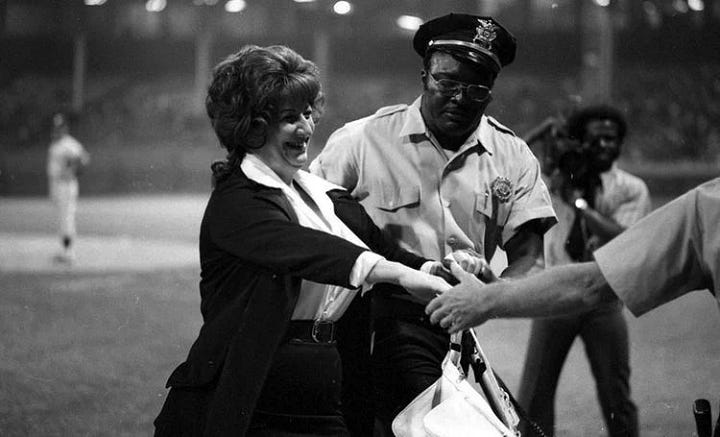
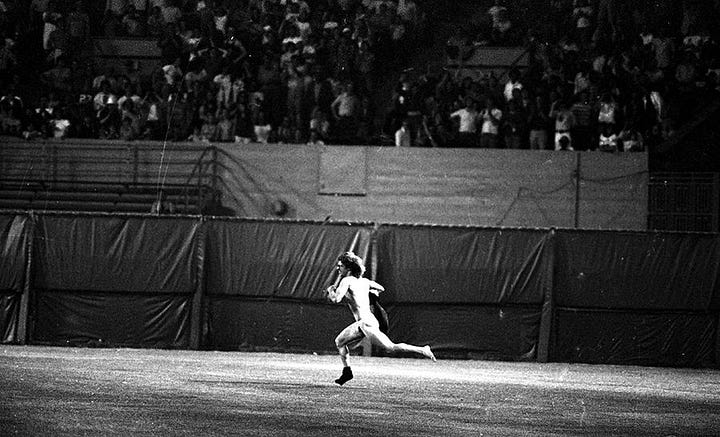
Things went to hell right away. Fans set off smoke bombs and firecrackers in the stands before the game started and continued to do so throughout the game. A chubby middle-aged woman ran onto the field and flashed the crown much to their delight. She was arrested after she tried to plant a kiss on third base umpire and crew chief Nestor Chylak. It was the second inning. After Rangers outfielder Tom Grieve hit his second home run of the game in the fourth inning, a streaker joined him and slid into second base. The following inning, a father and son later ran onto the field and mooned everyone. Streakers continued to invade the field throughout the game and the rowdy crowd chucked hot dogs at Rangers first baseman (and future Indian) Mike Hargrove. A half full gallon of Thunderbird was also chucked at Hargrove’s head and came mere inches away from hitting him. Not satisfied with harassing Hargrove, fans threw hot dogs and cherry bombs into the Rangers dug out.
Somehow the Indians and Rangers were able to play a baseball game during all of this, at least until the ninth inning. The Indians tied the ball game, and the winning run was on second base. That’s when a fan jumped on the field and stole Jeff Burroughs’ hat. Billy Martin, thinking his outfielder was being assaulted, grabbed a bat and told the Rangers “Let’s go get’em boys”. The rest of the team followed Martin to try and save Burroughs as more fans hopped on the field. Umpire Nestor Chylak defended Martin’s decision after the game telling reporters “…they had to because those fucking animals wanted to kill somebody.”

When the Cleveland Indians saw the Texas Rangers charge out of their dugout, they brandished bats and went to defend them from their own drunken fans. Hundreds of fans had stormed the field by this point and the ones in the stands were throwing batteries, bottles, rocks, and chairs. Indians pitcher Tom Hilgendorf and Nestor Chylak were both hit in the head with chairs during the melee. Hilgendorf covered his head immediately, not because he was seriously hurt but because he did not want anyone to see that his combover had been knocked out of place. Chylak was cut on the face. The Indians and Rangers brawled their way back to their dugouts avoiding knife and chain attacks from the fans. The police arrived to quell the mob, and it took nearly two hours for them to restore order. Nestor Chylak declared the game a forfeit. Surprisingly only nine people were arrested and miraculously nobody was killed. Recalling the riot decades later, Rangers catcher Jim Sundberg said, “We had Custer’s Last Stand in right field.”
After the riot was over, Nestor Chylak expressed his outrage to the press “Animals! Fucking animals! That’s what all these fucking people are!” Five years later Chylak would be on hand for the Disco Demolition Night fiasco. Chylak served in the U.S. Army during World War II and was awarded the Silver Star and Purple Heart for wounds sustained to his eyes from an artillery attack in the Battle of the Bulge. He had to be wondering what the hell he had fought for when he saw the generation that came after his engaging in debauchery and destruction without a care in the world.
The Cleveland Indians went ahead with their plans for another Ten Cent Beer Night. A strict beer limit was enforced this time, and two hundred police officers were there to make sure there was no unrest. The event went off without a hitch.
Stories My Dad Told Me
The following anecdotes are from my father. Born in 1966, he was an eyewitness to several chaotic incidents attending Detroit Tigers and Red Wings games during the 1970s. When he was eleven or twelve years old, he and his friend took a bus from their hometown in Hamtramck to Tiger Stadium. Their parents did not accompany them. Times were different then. My father doesn’t remember anything about the game because drunken fans in the center field grandstand were throwing batteries and M-80s, a particularly powerful firecracker that’s now illegal, at the players. The police had to intervene, and the centerfield grandstand was shut down for several games.
Hockey games were a particularly chaotic affair in those days. This was in part because the glass separating the spectators and the players was lower which allowed fans to take a swipe at the opposing team. The 1970s was an abysmal decade for the Detroit Red Wings. They were so bad fans dubbed them “The Dead Wings”. According to my father it was common for fans to throw whiskey bottles, beer bottles, keys, and batteries on the ice whenever the Red Wings lost. During a particularly heartbreaking loss to the Montreal Canadiens, then Canadiens head coach Scotty Bowman donned a helmet to protect himself from being hit on the head by any incoming objects.
Another incident my father was witness to came during a game between the Red Wings and Pittsburgh Penguins. Dave “The Hammer” Schultz of the Pittsburgh Penguins was single-handedly responsible for sparking the madness. Schultz was one of hockey’s most notorious enforcers. He holds the record for most penalty minutes in a season with 472 and he is the only player with two 400 penalty minute seasons, prestigious records which will never be broken. There was a delayed penalty Schultz committed during the game. He hid behind the Penguins goalie to avoid getting sent to the penalty box, much to the amusement of the audience. Later on, Schultz got into a fight with Dennis Polonich, a scrappy 5’6 center and both men were sent to the penalty box. A fan threw a rubber chicken at Schultz while he was in the sin bin prompting him to turn around and swipe at the fans with his stick. When Schultz and Polonich were done serving their time, they exited the penalty box and proceeded to get into another brawl. Instead of greeting Schultz with a rubber chicken, this time someone threw firecrackers into the penalty box. Schultz emerged from the box unharmed, got into another fight with Polonich at which point they were both ejected.
The Final Beatdown
The last incident of 1970s sporting event violence happened on December 23, 1979, during a game between the New York Rangers and Boston Bruins. Fittingly this crescendo was also the ugliest event. As per the course during this era, the game was filled with fights and skirmishes. When the Bruins won the game, Bruins forward Al Secord took the opportunity to exact revenge on Rangers forward Ulf Nilsson for punching him earlier in the contest. Members of both teams joined in the skirmish and during the chaos, John Kaptain, a fan in the crowd, reached over the glass and hit Stan Jonathan of the Bruins with a program giving him a paper cut. To add insult to injury, Kaptain took Johnathan’s stick right after he hit him. Bruins Captain Terry O’Reilly, one of the most intimidating players of the era, saw what happened and climbed over the class to give Kaptain a beating. When the other Bruins saw O’Reilly go into the stands, they did what all good hockey players do. They followed their captain into battle. Kaptain was able to escape from O’Reilly’s clutches, but Peter McNab and Mike Milbury traveled nearly eight rows up to nab him. They showed no mercy on Kaptain. The two men forced Kaptain down on the ground and Milbury tore off his shoe and brutally whacked him with it. All the while, the other Bruins were fighting with the other fans who had not fled. Nobody involved was convicted of a crime.
One would think the Bruins would be harshly punished and possibly banned from hockey for doing something so dangerous. Instead, Terry O’Reilly was suspended for eight games and Mike Milbury and Peter McNab were suspended for six. Every Bruin except for goalie Gary Cheevers was fined $500. The glass separating the players and the fans was raised shortly thereafter.
Things Calm Down
Why were sporting events in the 1970s so chaotic? Well, it was a chaotic period. Race riots and Martin Luther King Jr. and Robert F. Kennedy’s assassinations kicked off the period of unrest in the late 1960s. The 1970s saw the Fall of Saigon, stagflation, Watergate, and street drugs placing the nation in a chokehold it hasn’t let go of. There was also a glut of Baby Boomers coming of age who were using these drugs for the first time. It turns out raging hormones and substance abuse are a toxic combination. It was an angry time, and sports tend to make people irrationally angry. Riots at sporting events decreased during the 1980s due to better security and now American sports fans are remarkably well behaved in comparison to their European and Latin American counterparts. Nearly half a century on, it appears the turbulence of 1970s sports was an anomaly. The people reading this article will no doubt get a good laugh out of it, but a kid going to a game with his parents today isn’t going to be in any danger of getting hit in the face with a firecracker or accosted by a drunk. This is a good thing. Now we can watch our favorite teams let us down in peace.

